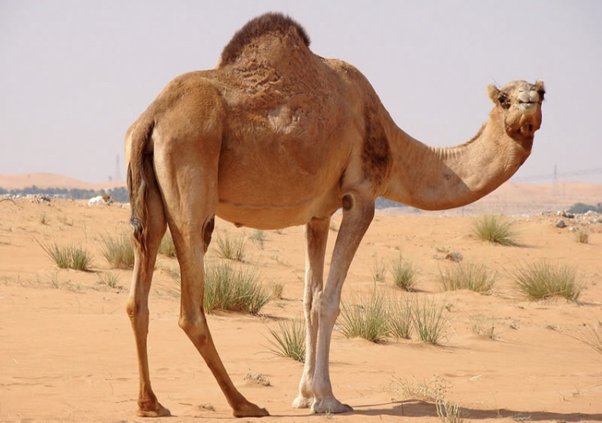Camels are ungulates, or ‘hoofed animals,’ with even toes. Several species of ungulate animals have overall weight that is almost equal in between third and fourth toes as they walk around. Camels are endemic to western Asia’s dry deserts, as well as central and eastern Asia. Camels are named from the Greek word kámlos, which is taken from the Hebrew word ‘gamal’ or the Arabic word ‘Jamal.’
There are two primary kinds of camel: the Dromedary Camel, also known as the Arabian Camel, which has a single hump and lives in warmer climates, and the Bactrian Camel, which has two humps and lives in harsh cold climates.
The ancestors of contemporary camels emerged in North America during the Palaeogene period (a period of geologic time spanning 42 million years during which mammals evolved) and eventually moved to Asia, according to fossil evidence.
There are almost 14 million domesticated Dromedary camels surviving today, mainly in Somalia, Sudan, Mauritania, and neighboring countries.

The Bactrian camel previously had a large array, but it has now been limited to an estimated 1.4 million domesticated animals. Around 1000 wild Bactrian camels are estimated to exist in China and Mongolia’s Gobi Desert.
Between 3,500 and 3,000 years ago, humans tamed camels for the first time. Both the Dromedary and Bactrian camels are still used for milk (which is more nutritious than cow’s milk), meat, and as beasts of burden (animals maintained by humans and trained as working animals), the Dromedary camel in western Asia and the Bactrian camel in central Asia.

Camels are members of the Camelidae biological family, the only extant family in the Tylopoda suborder. Camels are huge animals that eat only plants. Camels are distinct from ruminants in a number of respects.
Camels have a three-chambered digestive system rather than a four-chambered one. Camels have a split top lip with each part moving independently, as well as an isolated incisor in the upper jaw.

An mature camel stands 1.85 meters (6 feet) tall at the shoulder and 2.15 meters (7 feet) tall at the hump. Camels can sprint up to 65 kilometers per hour (40 miles per hour) and maintain speeds of up to 40 kilometers per hour in short bursts (25 miles per hour).
A camel’s lifespan ranges from 30 to 60 years.
The term camel is frequently used to refer to any of the six camelid-like species that make up the Camelidae family. The two real camels, as well as the Llama, Alpaca, Guanaco, and Vicua, four South American camelids.

The humps on camels are well-known. The hump or humps of a camel extend around 30 inches from its torso. Camels, on the other hand, do not store water in their humps as is popularly thought, however they do it in a roundabout way. Camels’ humps are a reservoir of fatty tissue, whereas their blood is a reservoir of water.
When this tissue is metabolized, it becomes not just a source of energy, but also a supply of oxygen. This allows camels to go for two weeks without water and up to a month without meals.
Camels can survive temperature and water content variations that would harm most other animals. Their body temperature ranges from 34°C (93°F) at night to 41°C (106°F) during the day, with only a little increase in temperature causing them to sweat. They are able to save about five litres of water every day as a result of this. Camels can lose as least 25% of their body weight owing to sweating.
Their nostrils are designed in such a way that when they exhale, a considerable amount of water vapour is caught and returned to their bodily fluids, minimizing the amount of water lost by breathing.

The thick coat of a camel reflects sunlight. To avoid overheating, a shaved camel must sweat 50% more. It also protects them from the scorching heat radiated by hot desert sand. Their lengthy legs assist them in staying away from the heated earth. Camels have strong feet to cope with the hot desert sands. If given the opportunity, camels have been known to swim.
Camels have a strong tongue and can eat through prickly desert vegetation. Long eyelashes and ear hairs, as well as closeable nostrils, provide an efficient sand barrier. Camels pace by moving both legs on one side at the same time, and their wider feet prevent them from sliding into the sand.
Camelids are known to have a highly unique immune system, with immunoglobulins lacking the light chain constituting part of the antibody repertoire. It is still uncertain whether or not this adds to their tolerance to harsh environments.







